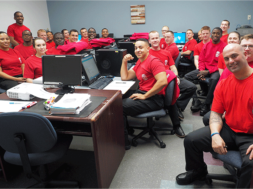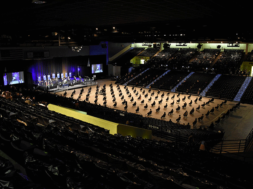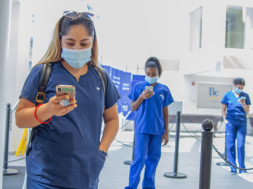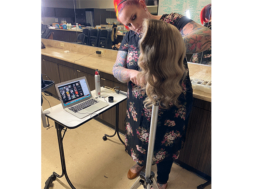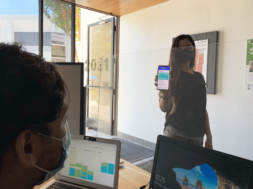
Lincoln Educational Services Team Rallies Together to Continue Delivering Education to Students
Interview with Scott Shaw, President and CEO, Lincoln Educational Services
Below is our interview with Scott Shaw, President and CEO, Lincoln Educational Services. This interview took place at the end of May 2020. Lincoln Educational Services has more than 11,000 students in its 22 campuses in 14 states under three brands: Lincoln Technical Institute, Lincoln College of Technology and Euphoria Institute of Beauty Arts and Sciences. Lincoln was founded nearly 75 years ago and focuses on three main areas: automotive transportation; skilled trades such as welding, HVAC and electrical; and health care, such as medical assisting and licensed practical nursing.
CER: When the pandemic began, did you move to remote learning?
Scott Shaw: Yes, on March 17, 2020, we announced that we were closing all the campuses and moving everything online. I have to give my hats off to our faculty for really rallying to the cause. It was really very gratifying to see how quickly we were able to respond. We moved all of our programs. It took us about 10 days.
We had to get some regulatory approvals and some other signoffs, given how many different states we’re in. But we were able to get every program up and running with an online delivery platform.
We’ve also worked with states and accreditors and where it was possible we were instituting simulations and other options in order to help replace some of the externships or clinical sites that may have been required for certain careers, especially in the healthcare area. As of today (May 26, 2020) we’ve opened up four of our campuses. We’re located here in New Jersey with six campuses and we’re hearing more and more doctors’ offices and other facilities of that nature opening up and asking for students to come in for their clinical portion. Things are slowly getting back to normal, but it’s going to be a long time before we’re fully back to normal.
CER: Regarding the reopening process, four of your campuses have started to reopen?
Shaw: Yes. We have a campus in Dallas, a campus in Nashville, a campus in Indianapolis and then Denver opened today (May 26, 2020). We have a committee that tracks and follows what all the national and local rules and regulations are about reopening. We follow whatever their guidance is. We’ve implemented a number of steps that are required by federal guidelines. Sometimes local jurisdictions might have even more specific guidance. But basically what we’ve done is we’ve broken down our schedules and broken down the classes into much smaller groups that come on campus at staggered times and are going to very defined areas within the campus. Everyone who comes on campus gets their temperature taken every day. They fill out a form asking if they feel healthy or not. They are social distancing. We’re encouraging them to wash their hands. We’re making sure that every day facilities are thoroughly sterilized so that people can remain as safe as possible.
If people don’t want to come back for personal reasons, they may have to suspend their education until they’re more comfortable. But we are still offering everybody online training throughout this period of time. We’re just opening up the schools at this time to allow students to come back to do some hands-on work. But they will continue with their online education for all the didactic portions for the foreseeable future.
CER: Do you have staff that are not comfortable coming back?
Shaw: We’re all working remotely now. If there’s a faculty member that’s uncomfortable coming back to the do the lab work, we’ll just reassign them so they can do more of the online training and support of students.
CER: You did mention that all of your departments and staff are currently working remotely, correct?
Shaw: Yes. We’re doing the admissions process, financial aid, career services remotely. Everything is currently 100% remote. We are asking certain people in each department to come back on to campus, just to help support those students who want to see a person face to face. But the good news is we’ve been able to operate for almost over two months now 100% remotely, so we know it can be done.
CER: Can you tell us more about your social distancing guidelines?
Shaw: In most places, it’s a 9-1 ratio in a class – 9 students and 1 instructor. Typically our classrooms could hold up to 30 students. So there will be fewer students in a classroom and we will be making sure that they’re 6 feet away. They will also be required to wear masks. All the staff will be required to wear masks. That’s become one of the more challenging things as we reopen schools to make sure that people keep their masks on. Frankly, they can be quite annoying, especially if you’re a faculty member with it on for eight hours. You need to get comfortable with it and give people breaks as well where they can be in a spot where they don’t have to have the mask on for a brief time.
CER: Will you be providing the PPE for both students and faculty?
Shaw: Yes. We have lots of signs and posters about washing your hands, staying 6 feet apart and how to safely cough or sneeze and to make sure if you’re not feeling well you stay home and give us a call in advance. If someone isn’t feeling really well and we take their temperature and it seems to be elevated, we ask that individual to go to a doctor and get a note and get retested. As I said, we’re following all the recommendations that are out there. We’re just trying to keep people safe, but at the same time allowing students to continue their education or complete their education with their hands-on portion.
CER: Did Lincoln have distance education before the pandemic?
Shaw: We had tried six or seven years ago to start offering online education. We did offer several courses in a blended format. We’ve used Canvas, which is an LMS, which a lot of schools use for their online delivery. So, we had all the tools and the capabilities, it just had to be dramatically scaled up and we had to teach a lot more people how to utilize these tools. We weren’t ignorant to it, we had already moved our largest program, automotive, to be completely done on a laptop.
Students don’t get textbooks anymore. Every automotive student gets a laptop and the curriculum is delivered on the laptop.
Our nurses all get laptops and there is testing, quiz taking and training support that was already being delivered virtually. But we didn’t have online courses per se.
CER: Do you think moving forward that distance education will continue for your schools?
Shaw: Absolutely. Everyone likes it. Typically our students come in four or five days a week. We hope to cut that down to three to four days a week. It just builds in a lot more flexibility for people. They save money and they don’t have to commute. It helps them with their childcare. A lot of people enjoy the flexibility of being able to do their class work when they want to. Most of our programs to date are synchronous versus asynchronous. We’ve been trying to structure a typical class day, so people know that at 8:30 they have to sign on and the instructor is going to be there to start class. We’re doing a lot of videos in Zoom and other things of that nature. It’s all live as if you’re in the classroom.
CER: That’s what I’ve been hearing from a lot of from our schools.
Shaw: We all kind of knew that would be the response. But if you sat us down in a room, and tried to decide how we could do this and what the impact would be, we’d still probably be discussing it today-two or three months later. In reality, in less than 10 days the whole organization was completely transformed and people have responded very well from the very beginning.
CER: Have you had any issue regarding your accrediting body or state regulatory bodies?
Shaw: We have had challenges because we’re in different states. For example, the Board of Nursing in Connecticut seems to not be as receptive to simulations compared to other states that seem to have adopted that as a strategy. They’ve adopted it in Connecticut but on a much more limited use. We’re constantly working with them and trying to educate them on what we’re doing in other states just to get them comfortable that this is very viable and these are the results that we’re getting from students who have completed this type of exercise. I would say that most of the accreditors have been very responsive and understanding and have worked with us to create other solutions given the challenges that are out there.
CER: Has your marketing strategy changed for enrolling new students?
Shaw: No. Maybe some of the messaging has changed. The reality is we’ve always been a career education company.
We’ve always thought that the careers that we train for are very important and meaningful. Now you have a period of time where we’re being classified as essential, critical infrastructure workers.
People are realizing that if my car’s not running, or the Amazon truck is not running to deliver our products or deliver things to the store, everything really starts breaking down in our society. If you’re at home and your electricity goes out, or your air conditioning is not working, your quality of life is dramatically impacted. All of a sudden everything that we’re training for, such as our LPNs or our Medical Assistants, are all programs that are classified by Homeland Security as critical infrastructure workers. I think it’s great that they’re finally getting the attention and respect for what they do. From a marketing standpoint, we’re just trying to really highlight what important jobs these are and also the fact that these are individuals who are on the frontline. Certainly, our LPNs and Medical Assistants are helping to make sure that things are functioning. The same is true in our skilled trades and automotive side.
CER: What has been your biggest challenge during the pandemic and with reopening?
Shaw: I think the challenge is trying to pull an organization together when everyone is at home. It’s a lot easier to rally the troops when you can all get in a big conference room and see people’s expressions and communicate simultaneously.
The thing that was much easier was the fact that everybody just embraced the change and put in the sweat equity and the additional time and thought needed to transition. There were a lot of people who I didn’t know very well that really have risen to the occasion to step up and lend a hand and make a real difference. All those things are great positives through all this. You really see the best of people coming out, which is great. We’re really talking about the future and where we’re going to go and how we’re going to build on this, versus people wallowing in the past or just feeling overwhelmed or feeling victimized.
CER: Have you received your HEERF funds and have you started to distribute them?
Shaw: We received all of them. The Department gave some sort of guidelines and our approach was to mimic what the government did. Between 75% and 80% of our students are PELL eligible. We can see what their EFC score is. Those with a lower EFC score received more funds than those with a higher EFC score. That was the basic criteria that we used to allocate the funds. We allocated out to all of our students that were Title IV eligible.
CER: What is one thing that you learned from the pandemic that will help you in the future?
Shaw: I think that you always have to keep a very positive attitude. If you start letting adversity get you down, you’ll never move forward. As I said, people at Lincoln really took this as a challenge. I’ve been at Lincoln maybe 20 years now and the most rewarding aspect of it has been that people just rallied to make sure that they could continue delivering education to the students. It’s not something we trained for or had a plan in place for, it just speaks more to the event itself and how it’s pulled people together.
CER: What do you think career education will look like post-pandemic? Do you think it will change?
Shaw: I think it will change. It has to change. We have to figure out ways to make it as affordable and accessible as possible. I think that the attention that career education is getting now is going to help drive even more demand. I think that we’ll be seeing some of the better times for career education and it’s going to get the respect it always should’ve had. I think that certainly the way that we deliver education is going to get better and more engaging. Because of all this, we’re exploring using virtual reality elements. We are just at the beginning stages.
But I think that’s going to become a technology that really plays well into a lot of what we do and how we train people and get people comfortable and expose people to these professions. I just see things getting better and not worse.




